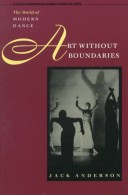Treating modern dance as a self-renewing art, Anderson follows its changes over the decades and discusses the visionary choreographers (some of whose lives are as colorful and tumultuous as their creations) who have devised new modes of movement. Art without Boundaries begins with an analysis of the rich mixture of American and European influences at the end of the nineteenth century that prompted dancers to react against established norms. Anderson shows how reformist social and educational ideas as well as the impact of the arts of Asia and ancient Greece led such pioneers as Loie Fuller, Maud Allan, Isadora Duncan, and Ruth St. Denis to forge deeply personal views. Anderson discusses the increasingly bold approaches of choreographers and dancers after World War I, how the politically troubled thirties gave rise to social protest dance in America, and how the menace of facism was reflected in the work of European practitioners. Following World War II many European nations turned to ballet, whereas American modern dance prospered under inventive new choreographers like Jose Limon, Merce Cunningham, Paul Taylor, and Alwin Nikolais. The book concludes with an authoritative view of how modern dance thrives once again on a worldwide basis.
- ISBN13 9780877456773
- Publish Date 28 February 1999 (first published 1 June 1997)
- Publish Status Active
- Publish Country US
- Imprint University of Iowa Press
- Format Paperback
- Pages 384
- Language English
